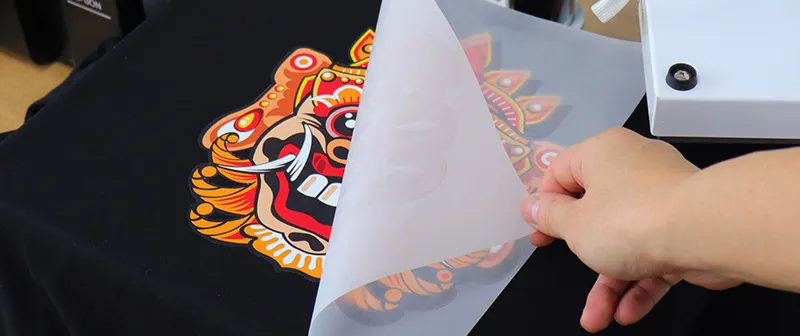DTF Printing Transformation: Unleashing Creative Thinking in Textile Design and Manufacturing
Wiki Article
Ultimate Guide to DTF Printing Methods for Sensational Textile Styles
Starting the journey of mastering DTF printing methods can open a world of possibilities for creating visually fascinating fabric layouts. As the fabric sector proceeds to evolve, staying ahead of the contour with innovative printing methods is essential. In this guide, we will certainly explore the complex information of DTF printing, from understanding the essential essentials to unraveling progressed color methods that can boost your designs to brand-new heights. Remain tuned as we look into the subtleties of selecting the best materials, improving the printing procedure, and getting over usual difficulties to accomplish sensational outcomes.Comprehending DTF Printing Essentials
DTF printing, a process that entails transferring designs from an unique film to textiles making use of warm and stress, develops the structure of textile printing techniques. This innovative technique enables top notch, dynamic designs to be effortlessly moved onto different fabrics with accuracy and detail. The initial step in DTF printing involves producing or picking a style that will be published onto the textile. This layout is then printed onto a special movie utilizing a DTF printer, which uses details dyes or pigments to make sure color accuracy and resilience.The final result is a stunning, resilient fabric style that is cleanable, adaptable, and immune to fading. Overall, understanding the fundamentals of DTF printing is crucial for understanding this modern-day fabric printing strategy.
Choosing the Right Fabric Materials
Having actually established the fundamental principles of DTF printing techniques for textile layouts, the following essential factor to consider exists in selecting the suitable fabric materials to enhance this cutting-edge procedure properly. Furthermore, the stretchability of these products can suit the warm transfer procedure involved in DTF printing without misshaping the layout. By picking the appropriate fabric products, designers can optimize the potential of DTF printing to develop stunning and lasting textile designs.
Mastering the Printing Refine
To master DTF printing techniques for textile designs, understanding the printing procedure is necessary for accomplishing consistent and top notch results. The printing process in DTF involves a number of vital steps that need precision and attention to information. To start with, preparing the art work for printing is crucial. This includes ensuring the design is correctly sized and positioned for the textile. Next off, the layout is printed onto an unique DTF movie utilizing a suitable printer with the best settings to attain optimum shade vibrancy and clearness (DTF Printing). Once the layout is printed, it is then transferred onto the material utilizing a warmth press maker. The temperature, stress, and duration of heat application have to be carefully managed to make sure appropriate wikipedia reference bond of the layout to the textile. In addition, understanding the peeling procedure after warmth pressing is important to avoid any type of damages to the style or textile. By refining each of these steps in the printing process, designers can consistently produce spectacular and resilient textile designs with DTF printing techniques.
Enhancing Layouts With Shade Strategies

Furthermore, experimenting with shade gradients can bring a feeling of motion and fluidity to the layout. By mixing shades effortlessly, a gradient effect can be accomplished, including a modern-day and vibrant touch to the fabric design. Additionally, making use of shade blocking techniques can produce striking and strong visuals by juxtaposing different solid colors in distinctive areas of the layout.
Furthermore, incorporating metal or neon shades can supply a special and eye-catching element to the fabric style, making it stand apart and exude a feeling of vibrancy. When tactically applied, these shade methods can raise the general visual charm of textile styles, making them much more exciting and remarkable.
Troubleshooting Common DTF Printing Issues
After discovering numerous shade methods to improve textile layouts, it is necessary to deal with usual DTF printing problems that may arise throughout go the production procedure. One typical issue is bad adhesion, which can arise from improper treating temperature levels or times. To resolve this trouble, make sure that the treating setups are precise which the sticky used appropriates for the details textile being printed on. An additional regular obstacle is shade inconsistencies, where colors may show up differently than anticipated. This can be triggered by incorrect color profiles or setups in the printing software. To tackle this, confirm the color setups and accounts to guarantee they match the intended style. Furthermore, problems with picture clarity and intensity can occur because of low-resolution photos or improper printing strategies. To address this, always utilize top quality pictures and change the printing setups for optimum clarity. By recognizing these usual problems and carrying out the required troubleshooting actions, you can boost the overall quality of your DTF published fabric layouts. why not try these outFinal Thought
Finally, understanding DTF printing methods is vital for developing stunning textile designs. By comprehending the essentials of DTF printing, choosing the ideal materials, and boosting layouts with color methods, one can attain impressive results. It is necessary to repair usual issues that might occur throughout the printing process to make sure an effective result. With technique and focus to detail, one can produce lovely and one-of-a-kind textile designs utilizing DTF printing techniques.DTF printing, a process that entails transferring layouts from an unique film to fabrics using warmth and stress, creates the structure of fabric printing strategies.Having developed the fundamental principles of DTF printing techniques for textile layouts, the following important consideration exists in choosing the appropriate textile products to complement this innovative process efficiently. By choosing the best fabric products, designers can make best use of the capacity of DTF printing to create long-lasting and spectacular textile styles.
To excel in DTF printing strategies for textile designs, mastering the printing process is crucial for attaining consistent and top quality outcomes. DTF Printing. By honing each of these actions in the printing process, developers can continually generate sturdy and sensational textile layouts with DTF printing techniques
Report this wiki page